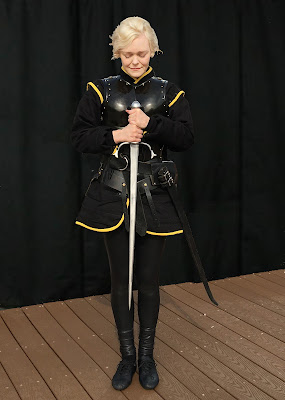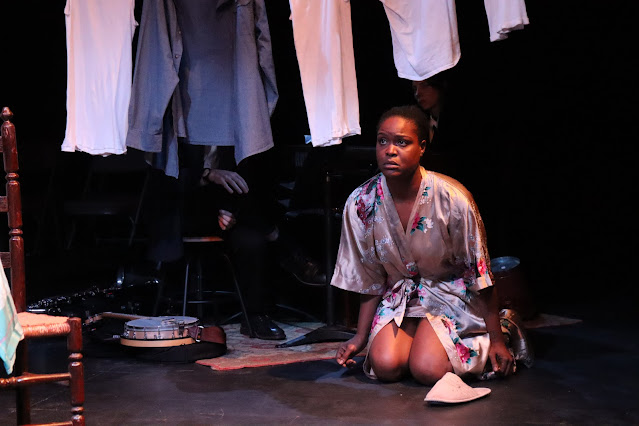Review: "Saint Joan" Displays Her Virtues in Lower Manhattan
Saint Joan
Written by George Bernard Shaw
Directed by Geoffrey Horne
Presented by Shakespeare Downtown at Castle Clinton
26 Wall St., Manhattan, NYC
June 16-26, 2022
 |
| Billie Andersson as Joan. Photo by Amy Goossens |
Saint Joan begins in 1429 with an argument between Captain Robert de Baudricourt (George Eve) and his steward (Davide di Cagno-Hagen) over a lack of eggs. The latter blames a curse linked to the "girl from Lorraine," also known as "The Maid," who has been trying unsuccessfully to meet with Robert and who wishes to be a soldier. When the seventeen (or so) year-old Joan (Billie Andersson) is granted her audience, the poised assurance with which Andersson invests her makes Eve's adult Robert seem bratty in comparison. She may not necessarily persuade Robert that the voices which she hears are indeed divine, but she does convince him to send her on to the Dauphin (Evan Olson) accompanied by gentleman-at-arms Bertrand de Poulengy (Malcolm Jackson) and her requested military accouterments. Despite meeting with a good deal of mockery at the court of the Dauphin, whom Olson plays as a comic figure, another childish man juxtaposed to Joan, she gets what she wants from him as well, helped, no doubt, by his enormous debts and disinclination towards soldiering. From there, she moves on to meeting Dunois, Bastard of Orleans (a standout Charlie Howard), some spectacular military victories, a trial for heresy, and…well, we won't spoil it for those who have never heard of Joan of Arc.
Shaw wrote in his preface to Saint Joan that there are no villains in the play, but another way of looking at this is that there are almost nothing but villains, all bound by the religious or secular political maneuvering with varying degrees of overt self-interest (the clergy's claims to be above politics notwithstanding). In a nice touch that reflects this dynamic, Mamadou Jalloh plays both one of Joan's most steadfast supporters, Captain La Hire, as well as the executioner. Even Joan, in, for example, her conversations with Robert de Baudricourt and Dunois, despite talk of everyone being God's subjects, espouses a xenophobic nationalism, and her god seemingly condones mass death in the service of language-based property rights. At one point, Joan says that she, her county, and her god are all alone, and one might see the loneliness of which she speaks reflected in how the characters in this production predominantly stand or sit apart and almost never touch one another. For the audience, however, Saint Joan is a fun, free way to be a part of summer in the city.
-John R. Ziegler and Leah Richards



Comments
Post a Comment